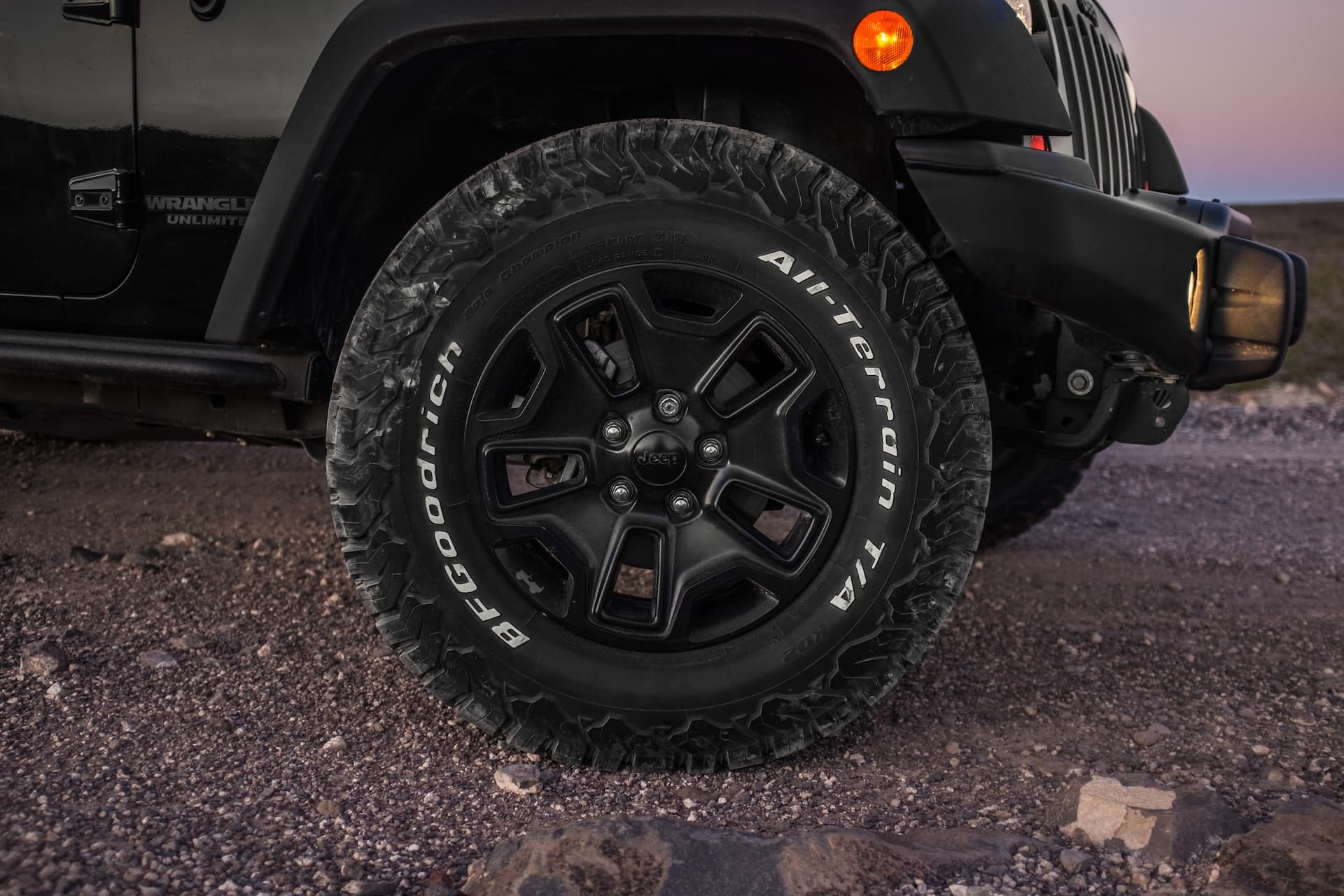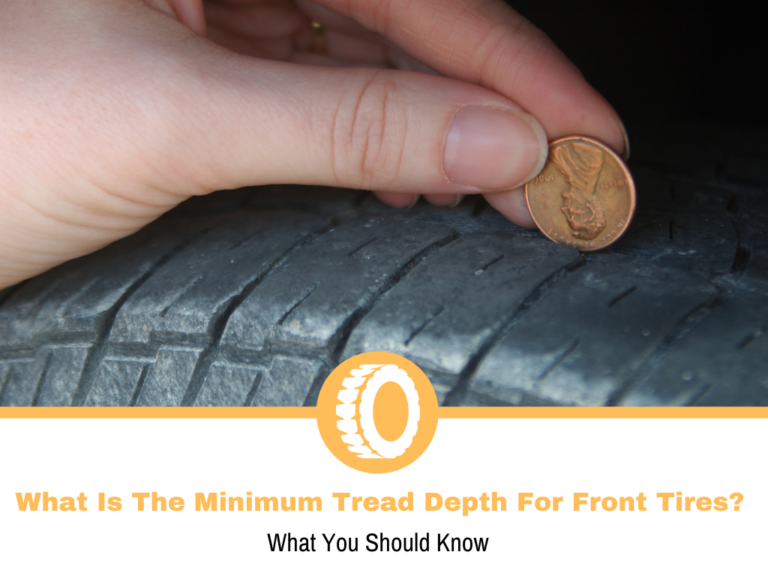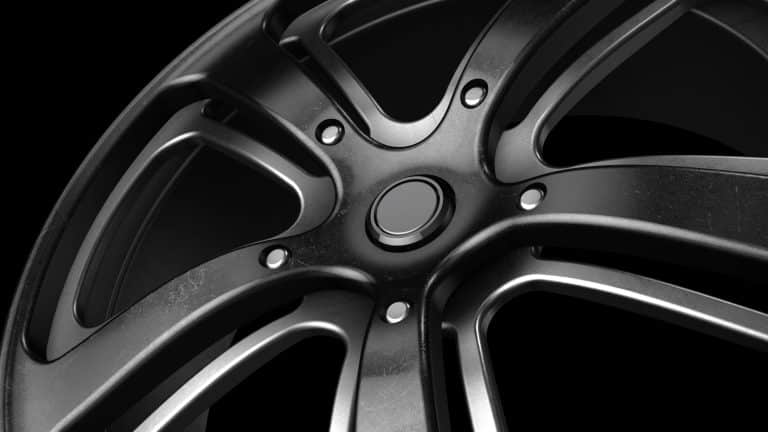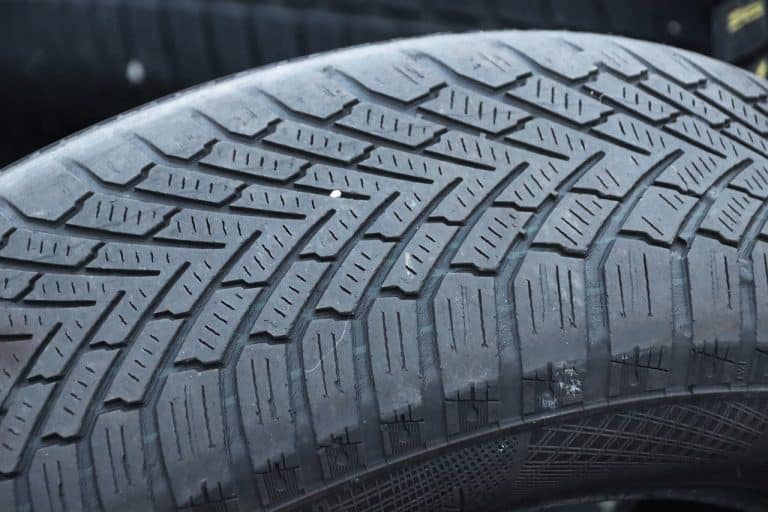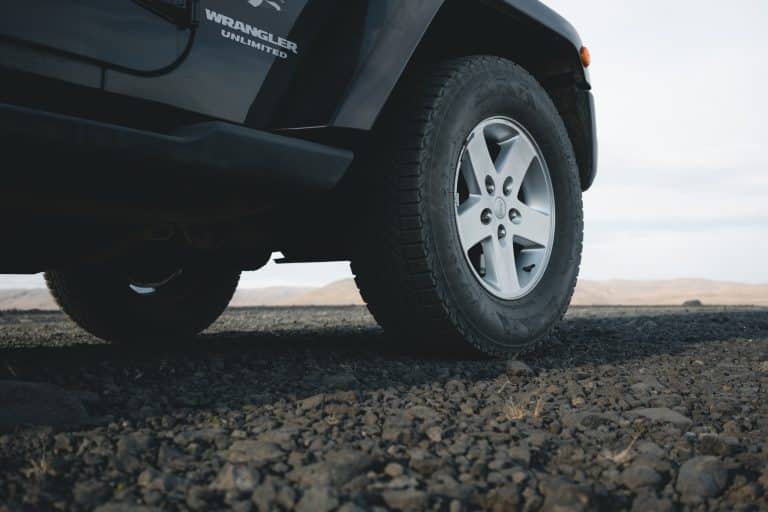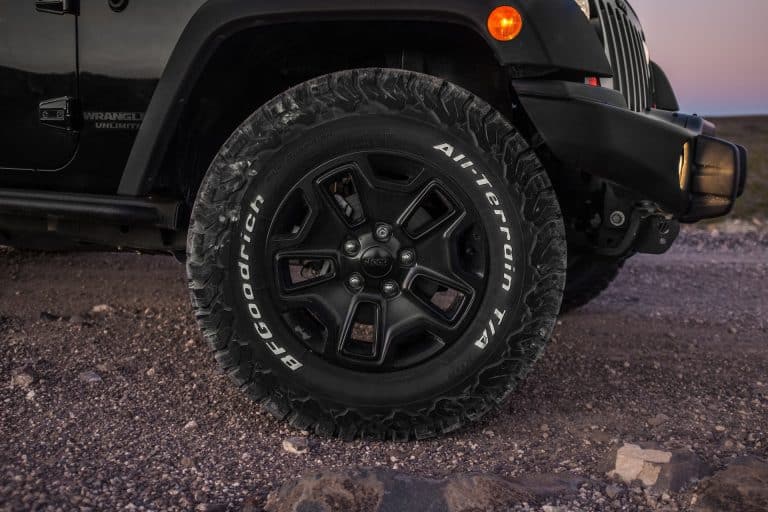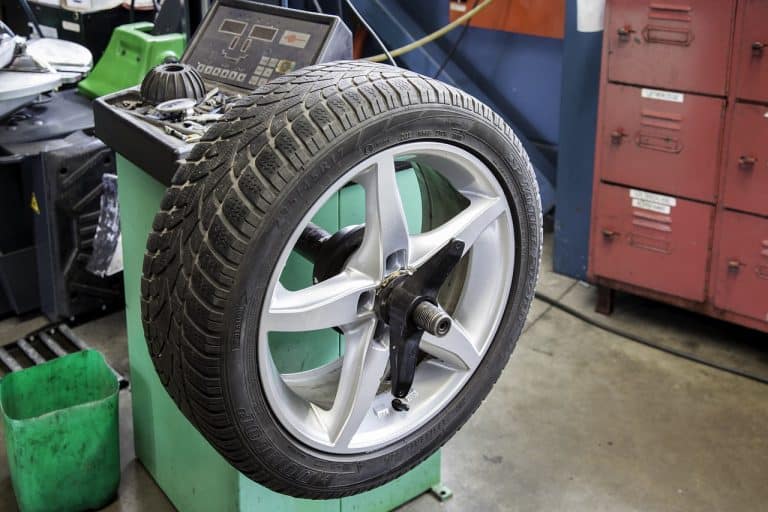The Ultimate Guide to Studded vs. Non-Studded Tires
Snow, sleet, ice, and temperatures below freezing make it harder to drive during winter. Aside from how well the driver handles winter hazards, safety also depends on how well the car is taken care of, which includes having the right tires.
One of the most significant decisions that involve this factor is whether you should pick a studded or non-studded tire.
Studded snow tires were the best for a long time, but improvements in rubber compounds and other winter tire technologies have made many drivers change their minds. Do you still need studded tires in the winter? Let’s look at how studded vs. non-studded tires perform in typical winter driving scenarios.
Studded vs. Non-Studded Tires
Studded tires have caused a lot of debate over the years. Some states have banned them, while others, like Washington, have put limits on their use and passed laws that require studs to be lighter.
Performance and safety issues with studded tires are hard to figure out. When the temperature is nearly freezing, and the roads are covered in ice, studded tires often have a better grip than other tires when they are new.
But, the new non-studded tires have made a small benefit less critical, and recent studies suggest that the small number of situations may not be enough to outweigh how bad they are for traction in dry or wet conditions on some types of pavement.
Studded tires are also linked to several primary and secondary safety factors, many of which are hard to measure, such as how drivers act and feel about safety.
What Are Studded Tires?
Studded tires have small rivets (studs) built into the tread and don’t come off. They are best for driving over ice and deep snow because the studs dig into the surface and give your tire more grip, just like soccer cleats do.
Most tire studs are made of metal. But, there are a few types of tires with studs made of hard rubber or plastic. As you might expect, metal studs are stronger and can easily break through the ice. But, they can are believed to damage paved roads more, which is why many states have made them illegal.
Rubber and plastic studs aren’t as strong as metal ones, but they cause less damage and are legal in more states.
Winter studded tires with metal studs are easy to spot because the studs stand out. Since these tires are only used in the winter, they are likely to have the same qualities as a non-studded winter tire, like a high number of sipes and sharp edges.
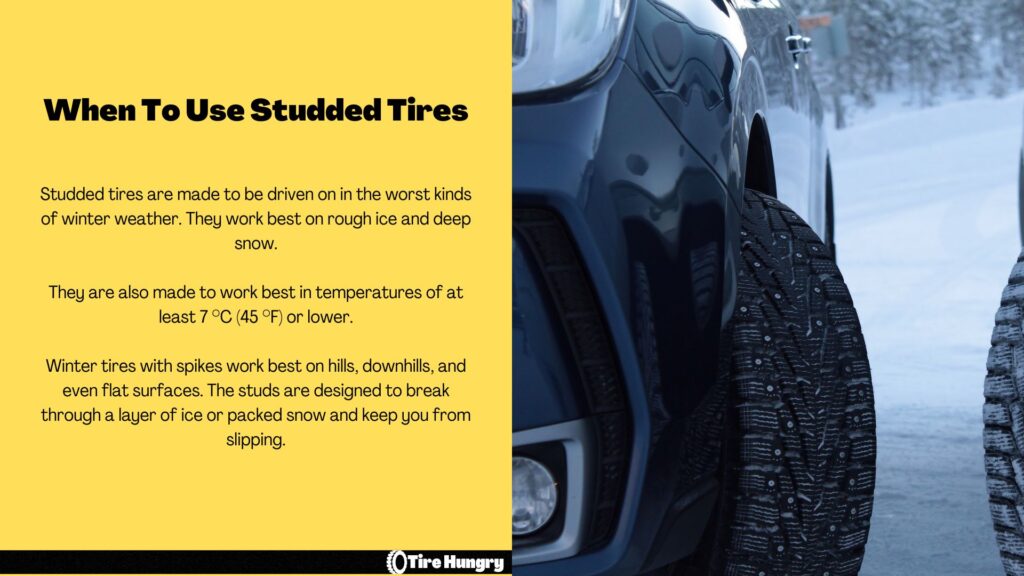
What Are Non-Studded Tires?
Non-studded tires, usually called “winter tires,” are different from other tires because they are made in a way that makes them best for driving on cold roads and through ice and snow.
Winter tires are made with unique rubber that stays flexible even when it’s cold. They have a “high sipe density” that makes them stand out. Since a winter tire stays flexible even when it’s cold, the “high density” of the edges that grip the road gives it more grip and stability.
Most of the time, the sipes run across the tread surface, help control forward movement, and shorten the time it takes to stop. As the wheel turns, the tread blocks’ angles and edges grab and pull the tire forward.
As the tire moves forward, the sipes open up and grab the snow or ice when they hit the ground. Here, the hard tread angles and high density siping make the tire better at handling winter roads.
If you look at the sipes on most winter tire models, you’ll see that they’re usually made in a zigzag pattern that goes against the tread pattern. This is done to improve traction in water, slush, and snow to reduce the chance of slipping.
Non-studded tires also have thick shoulder blocks on the outside edges of the tread. These blocks help the tire make more contact with the ground and last longer.
Lastly, non-studded tires are made of different kinds of rubber that stay more flexible when the temperature drops. Even all-season tires stiffen when the road is cold, making it harder for the tread to bend and grip the road.
In addition, less of the tire may be touching the road, which could hurt traction. So this doesn’t happen, non-studded tires are made to stay soft.
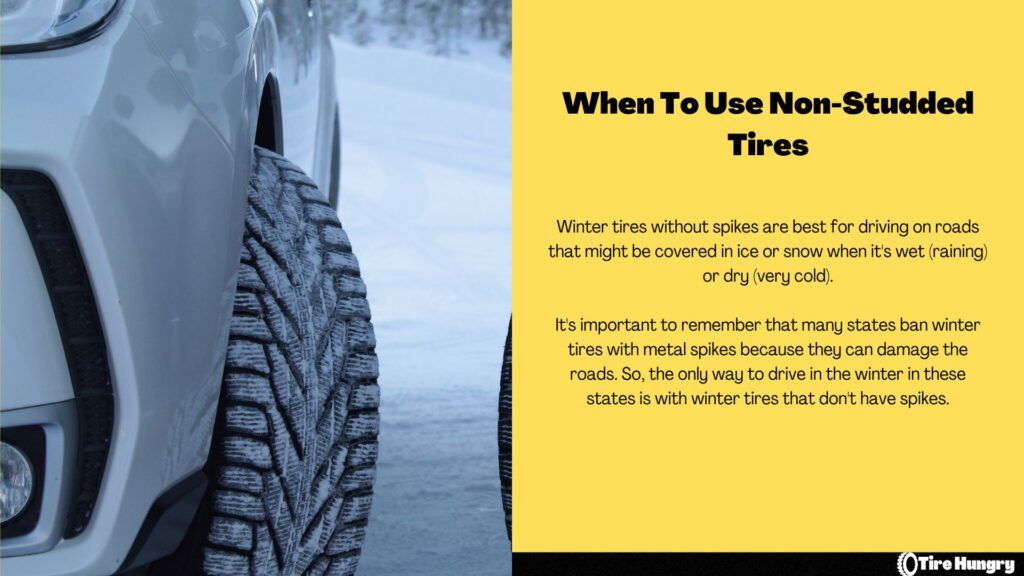
Do You Need Studded Tires for Winter?
Not too long ago, studded tires were the best way to stay safe on the road in the winter. But as tire technology has improved, non-studded tires have come out that sometimes work better than their studded counterparts.
Studded vs. Non-Studded Tires: Road Noise
Any winter tire will make more noise on dry, clear roads, but studded tires are much louder than non-studded tires in these conditions. When there is no snow or ice to bite into, the metal studs end up chewing on the road, which is loud and bad for both the road and the tire.
Because of this, most provinces have banned the use of studded tires from May to October (months may vary by state or province).
Studded vs. Non-Studded Tires: Tire Life
Whether you choose studded or non-studded tires, winter tires tend to wear out faster than summer tires.
Studded tires are made, so the studs wear out at about the same rate as the tread. This keeps the tires’ performance even. After a couple of seasons, non-studded tires may lose some performance as the softer, more flexible rubber wears away and the harder rubber underneath comes to the surface.
Even though the length of time a tire lasts depends on how well it was made and how well you take care of it, neither studded nor non-studded tires have a significant advantage over the other in terms of longevity.
Studded vs. Non-Studded Tires: Snow Driving
At a time, studded tires were the only option for good grip in the snow. Modern tire tread designs may now match a stud’s grip in the snow. The design of these sipe plays a significant role in creating snow traction; zigzag sipes, for example, can provide good grip by biting into snow in the same way that studs do.
In addition to providing a higher grip in the snow than classic studded tires, the increased flexibility of modern rubber compounds in cold weather is a welcome bonus.
Non-studded tires, as used in modern vehicles, are great for safety and grip in snow. However, studded tires provide an advantage while traveling over compacted snow.
Studded vs. Non-Studded Tires: Driving on Ice
If you often drive on icy roads or where the snow is packed down, you should still get tires with spikes. Modern non-studded tires work well in many winter driving conditions, but metal studs are better on wet ice or snow that has been packed down.
Studded vs. Non-Studded Tires: Driving in Unpredictable Weather
In this case, the non-studded tires are better. In countries like Canada – weather can be hard to predict. On Christmas Day, it might be 15°C and rain; in late April or early May, they might get a surprise blizzard.
Since bare roads can damage studded tires and studded tires can damage bare roads, you might choose a non-studded winter tire instead if the weather is changing quickly. These tires are much quieter and less damaging on smooth pavement.
The Legality of Studded Tires Per State
The permissibility of using studded tires has been mentioned above. So, let’s get into more detail about this subject.
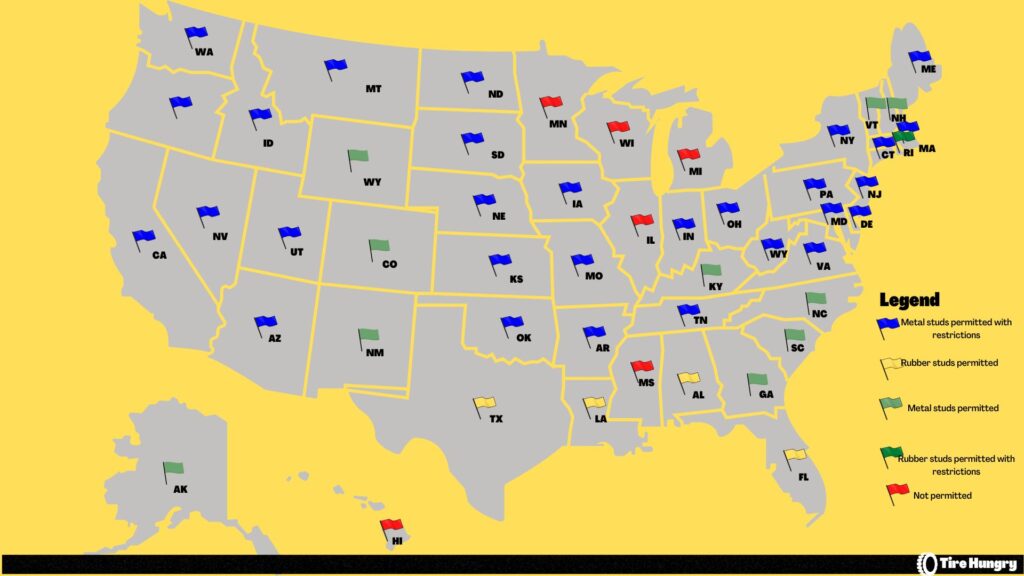
State laws limit how and when you can use studded tires. In other words, how, when, and where these winter tires can be used is up to each state. Even though this might seem overkill, studded tires damage the road and pavement when the right winter conditions aren’t there.
We mean that when the road isn’t covered in ice or, in some cases, packed snow, the studded tire will chip away the pavement when it comes in contact with the road. Over time, the tire’s contact with the road will damage the road surface, leading to potholes and other dangerous hazards.
Also, because the US is such a big country, the weather in its different parts is obviously very different. Studded tires can’t be used the same way in Florida and Montana, where the winters are very different (as Montana is nearer to the North Pole and so cold weather dominates during winters).
Because of such weather conditions, state laws control how and when these studded tires can be used.
If you want to know each state’s rules about studded tires, look at the table below.
| State | State Code | Studded Tires Regulation |
| Alabama | AL | Only rubber studs are allowed |
| Alaska | AK | Above 60 North latitude: Forbidden between May 1 & September 15
Below 60 North latitude: Forbidden between April 15 & September 30 |
| Arizona | AZ | Permitted between October 1 & May 1 |
| Arkansas | AR | Permitted between November 15 & April 15 |
| California | CA | Permitted between November 1 & April 30 |
| Colorado | CO | Permitted |
| Connecticut | CT | Permitted between November 15 & April 30 |
| Delaware | DE | Permitted between October 15 & April 15 |
| Washington DC | DC | Permitted only in Snow & Ice conditions |
| Florida | FL | Rubber studs only |
| Georgia | GA | Permitted only in Snow & Ice conditions |
| Hawaii | HI | Forbidden |
| Idaho | ID | Permitted between October 1 & April 30 |
| Illinois | IL | Forbidden |
| Indiana | IN | Permitted between October 1 & May 1 |
| Iowa | IA | Permitted between November 1 & April 1 |
| Kansas | KS | Permitted between November 1 & April 1 |
| Kentucky | KY | Forbidden |
| Louisiana | LA | Rubber studs only |
| Maine | ME | Permitted between October 1 & April 30 |
| Maryland | MD | Permitted in: Washington, Garrett, Frederick, Carroll, Allegheny
Between November 1 & March 31 |
| Massachusetts | MA | Permitted between November 1 & April 30 |
| Michigan | MI | Forbidden |
| Minnesota | MN | Forbidden |
| Mississippi | MS | Forbidden |
| Missouri | MO | Permitted between November 1 & March 31 |
| Montana | MT | Permitted between October 1 & May 31 |
| Nebraska | NE | Permitted between November 1 & April 1 |
| Nevada | NV | Permitted between October 1 & April 30 |
| New Hampshire | NH | Permitted |
| New Jersey | NJ | Permitted between November 15 & April 1 |
| New Mexico | NM | Permitted |
| New York | NY | Permitted between October 15 & May 1 |
| North Carolina | NC | Permitted up to 1/16 inch projections when compressed |
| North Dakota | ND | Permitted between October 15 & April 15 |
| Ohio | OH | Permitted between November 1 & April 15 |
| Oklahoma | OK | Permitted between November 1 & April 1 |
| Oregon | OR | Permitted between November 1 & March 31 |
| Pennsylvania | PA | Permitted between November 1 & April 15 |
| Rhode Island | RI | Permitted up to 1/16 inch projections when compressed
Between November 15 & April 1 |
| South Carolina | SC | Permitted up to 1/16 inch projections when compressed |
| South Dakota | SD | Permitted between October 1 & April 30 |
| Tennessee | TN | Permitted between October 1 & April 15 |
| Texas | TX | Rubber studs only |
| Utah | UT | Permitted between October 15 & March 31 |
| Vermont | VT | Permitted |
| Virginia | VA | Permitted between October 15 & April 15 |
| Virginia | VA | Permitted between October 15 & April 15 |
| Washington | WA | Permitted between November 1 & March 31 |
| West Virginia | WV | Permitted between November 1 & April 15 |
| Wisconsin | WI | Forbidden |
| Wyoming | WY | Permitted |
Conclusion
When deciding between studded and non-studded tires, it’s essential to think about several things. The most important is what the winter driving conditions are like in your area.
Studded tires might be the best choice if you often drive on roads with packed snow or layers of ice. This type of winter tire was made so that small metal studs, or sometimes hard plastic studs, can be safely put into the tread. Most studded tires can have between 80 and 100 studs put in each one.
If you live in an area where snow and ice don’t build up on the roads too often, you might get by with just a good set of winter tires. Non-studded tires are the best choice for driving in winter conditions with slush, snow, and ice.
Also, before you decide between studded and non-studded tires, you should check to see if your state lets you drive with them.
